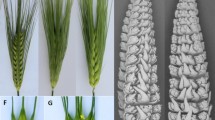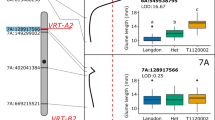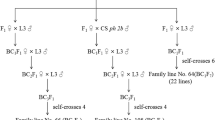Abstract
The Chinese wheat landrace, Xinjiang rice wheat (T. petropavlovskyi Udacz. et Migusch., 2n = 42), known as ‘Daosuimai’ or rice-head wheat is characterized by long glumes, and was found in the agricultural areas in the west part of Talimu basin, Xinjiang, China in 1948. The gene for long glume from T. petropavlovskyi was introduced into a line of spring durum wheat, LD222. The gene for long glume is located approximately46.8 cm from the cn-A1 locus, which controls the chlorinatrait. Significant deviation from a 3:1 in the F2 of LDN7D(7A)/ANW5C confirmed that the long glume of T. petropavlovskyi can be controlled by a gene located on chromosome 7A. The gene locates approximately 12.4 ± 0.5 cM from the centromere on the long arm of 7A. It is considered that the gene for long glume from T. petropavlovskyi is an allele on the P 1 locus, and it should be designated as P 1a. It is suggested that T. petropavlovskyi originated from either the natural hybrid between T. aestivum that has an awn-like appendage on the glume and T. polonicum or a natural point mutation of T. aestivum.
Similar content being viewed by others
References
Arbuzova, V.S., T.T. Efemova, L.I. Laikova, O.I. Maystrenko, O.M. Popova & T.A. Pshenichikova, 1996. Development of precise genetic stocks in two wheat cultivars and their use in genetic analysis. Euphytica 89: 11–15.
Chen, P.D., D.J. Liu, G.Z. Pei, L.L. Qi & L. Huang, 1988. The chromosome constitution of three endemic hexaploid wheats in Western China. In: T.E. Miller & R.M.D. Koebner (Eds.), Proc. 7th Int. Wheat Genet. Symp., Cambridge, UK, pp. 75–80.
Chen, Q., Y. Sun & Y. Dong, 1985. Cytogenetic studies on interspecific hybrids of Xinjiang wheat. Acta Agron Sin 11: 23–28.
Efremova, T.T., O.I. Maystrenko, L.I. Laikova, V.S. Arbuzova & O.M. Popova, 2000. Comparative genetic analysis of hexaplopid wheats Triticum petropavlovskyi Udacz. et Migusch. and Triticum eaestivum L. Rus J Genet 36: 1142–1148.
Gandilyan, P.A., 1972. Spontaneous hybridization, mutations and some aspects of the phylogeny of wheat. Soviet Genetics (English version of Genetika) 8: 949–960.
Jakubtsiner, M.M., 1959. K poznaniyu pschenits Kitaja. Bot Zhurn 44: 1425–1436 (in Russian).
Joppa, L.R. & N.D. Williams, 1988. Langdon durum substitution lines and aneuploid analysis intetraploid wheat. Genome 30: 222–228.
Klindworth, D.L., M.M. Klindworth & M.E. Duysen, 1995. Genetic analysis of chlorina mutants of durum wheat. Crop Sci 35: 431–436.
Klindworth, D.L., M.M. Klindworth & N.D. Williams, 1997. Telosomic mapping of four morphological markers of durum wheat. J Hered 88: 229–232.
Kosambi, D.D., 1944. The estimation of map distance from recombination value. Ann Eugen 12: 172–175.
Law, C.N., 1966. The location of genetic factors affecting a quantitative character in wheat. Genetics 53: 487–498.
Liepin, T., 1932. Inheritance of quantitative characters in durum wheat. III. The manifold effect of the principal gene of the glume length of Triticum polonicum. Akademija Nauk USSR, Trudy Laboratorii Genetiki, 9: 29–46 (in Russian).
Udaczin, R.A. & E.F. Miguschova, 1970. Novoe v poznanii roda Triticum L. Vestnik S.-Kh. Nauki 9: 20–24 (in Russian).
Watanabe, N., 1994. Near-isogenic lines of durum wheat: their development and plant characteristics. Euphytica 72: 143–147.
Watanabe, N., Y. Yotani & Y. Furuta, 1996. The inheritance and chromosomal location of a gene for long glume in durum wheat. Euphytica 91: 235–239.
Watanabe, N., 1999. Genetic control of the long glume phenotype in tetraploid wheat by homoeologous chromosomes. Euphytica 106: 39–43.
Watanabe, N., T. Sekiya, K. Sugiyama, Y. Yamagishi & I. Imamura, 2002. Telosomic mapping of the homoeologous genes for the long glume phenotype in tetraploid wheat (in press).
Yang, W.Y., C. Yen & J.L. Yang, 1992. Cytogenetic study on the origin of some special Chinese landraces of common wheat. Wheat Inform Serv 75: 14–20.
Author information
Authors and Affiliations
Rights and permissions
About this article
Cite this article
Watanabe, N., Imamura, I. Genetic control of long glume phenotype in tetraploid wheat derived from Triticum petropavlovskyi Udacz. et Migusch.. Euphytica 128, 211–217 (2002). https://doi.org/10.1023/A:1020829821620
Issue Date:
DOI: https://doi.org/10.1023/A:1020829821620




